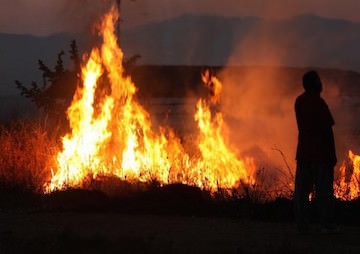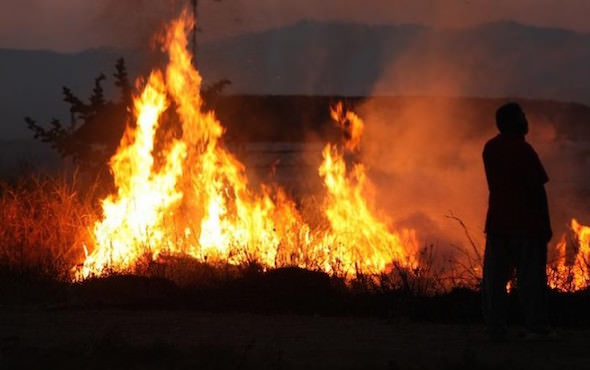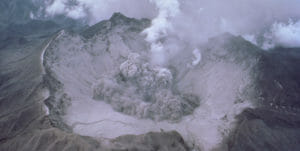Fire Activity Points to Religions’ Impact on Climate
A link has been detected between religious days of observance and reductions in the big “active fires” that can affect global warming by sending aerosols into the atmosphere.
By Tim Radford / Climate News Network

Burning the bush in Mozambique, southern Africa. (Senorhorst Jahnsen via Flickr)
This Creative Commons-licensed piece first appeared at Climate News Network.
LONDON — Australian scientists have identified a weekday-working pattern for mankind’s oldest employee: fire.
On a global scale, those fires big enough to be detected from space are at their most industrious on a Tuesday, and likelier to take a day of rest on a Sunday.
This is most true in Africa, Australia, North America and other parts of the Christian world. In North Africa and parts of Asia, such as Kazakhstan, the fires tend to die down on a Thursday, and on Friday — the sacred day for Muslims. Evidence for a weekly cycle in China and India was not so consistent.
The study, in Geophysical Research Letters, is only indirectly linked to global warming due to the human combustion of fossil fuels. However, it does put in place another piece of the great climate change jigsaw puzzle.
Rainfall patterns
That is because aerosols from what the scientists call “active fires” — which include controlled burning to recycle nutrients and nourish grazing lands, as well as accidental blazes and even arson — can warm the climate directly by absorbing solar radiation.
They can also scatter and reflect sunlight and play a role in damping down global or regional temperatures. And since water vapour can condense around aerosols and form cloud droplets or even ice, these same tiny particles of burned foliage have a part to play in rainfall patterns.
Nick Earl, an Earth scientist at the University of Melbourne, and colleagues went looking for evidence of a weekly cycle in the planetary fire regime in the data collected between 2001 and 2013 by two NASA satellites fitted with moderate resolution imaging spectrometers (MODIS) that can resolve the infrared evidence of the larger active fires.
More than a billion blazes were identified in the data, and Sunday was the least active day, with only 104 million fires. That is 8% lower than the tally for fires on a Tuesday, which, for most of the world, is around the middle of the working week.
“Nature doesn’t adhere to the weekly cycle,
so this really highlights the influence we have
on the planet when it comes to fires.”
There were 208 days with no data at all — the instruments require cloud-free vision — and eight days with fire counts that were clearly erroneous. But the Melbourne scientists had evidence enough to detect patterns of change during the seven-day cycle, and which varied according to season, economic status, and national and geographical boundaries.
“This study shows there’s a very clear weekly pattern to fires around the world,” Dr Earl says. “Nature doesn’t adhere to the weekly cycle, so this really highlights the influence we have on the planet when it comes to fires.”
In forests, peatland and in the tundra, wildfire is likely to increase as global average temperatures inch ever higher, and heatwaves and extended drought make woodlands and scrub more vulnerable.
Climate machine
Climate scientists have a separate interest in wildfire as an instrument in the climate machine, because forests are repositories of atmospheric carbon, taken from the air by photosynthesis and stored as wood and leaf. When forests burn, they put huge quantities of carbon dioxide back into the atmosphere.
But humans also use fire as an instrument. Foresters stage controlled burns to lower the risk of dangerous conflagration, pastoralists burn grassland to recycle nutrients and stimulate new growth, and agriculturalists burn stubble and waste to add nourishment to soil.
Of the active fires detected, 43% were in Africa. The “Sunday effect” in those southern parts of the African continent that follow the Christian calendar was pronounced, while in the mainly Muslim countries of northern Nigeria, Chad and Sudan, the second lowest count was on a Friday.
Unexpectedly, India showed the highest number of fires on a Sunday, the nation’s day of rest. But Muslim Indonesia and Kazakhstan in central Asia had minimums on Thursday and Friday.
“Friday is the ‘day of assembly’ and prayer for the Muslim faith, so it actually strengthens the argument for how religion impacts our climate,” Dr Earl says.
Tim Radford, a founding editor of Climate News Network, worked for The Guardian for 32 years, for most of that time as science editor. He has been covering climate change since 1988.
Your support matters…Independent journalism is under threat and overshadowed by heavily funded mainstream media.
You can help level the playing field. Become a member.
Your tax-deductible contribution keeps us digging beneath the headlines to give you thought-provoking, investigative reporting and analysis that unearths what's really happening- without compromise.
Give today to support our courageous, independent journalists.







You need to be a supporter to comment.
There are currently no responses to this article.
Be the first to respond.